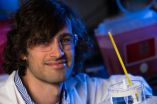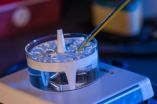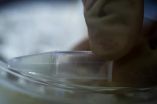(Press-News.org) HOUSTON – (May 7, 2014) – Rice University bioengineers have created a hydrogel that instantly turns from liquid to semisolid at close to body temperature – and then degrades at precisely the right pace.
The gel shows potential as a bioscaffold to support the regrowth of bone and other three-dimensional tissues in a patient's body using the patient's own cells to seed the process.
The hydrogel created in the lab of Rice bioengineer Antonios Mikos is a liquid at room temperature but, when injected into a patient, becomes a gel that would fill and stabilize a space while natural tissue grows to replace it.
The new material detailed in the American Chemical Society journal Biomacromolecules takes the state of the art a few steps further, Rice scientists said.
"This study describes the development of a novel thermogelling hydrogel for stem cell delivery that can be injected into skeletal defects to induce bone regeneration and that can be degraded and eliminated from the body as new bone tissue forms and matures," said Mikos, Rice's Louis Calder Professor of Bioengineering and Chemical and Biomolecular Engineering.
A problem with thermogelling polymers is that once they harden, they begin to collapse and then force out water, said Rice graduate student and the paper's lead author, Brendan Watson. That process, known as syneresis, defeats the purpose of defining the space doctors hope to fill with new tissue.
"If the transition gellation temperature is one or two degrees below body temperature, these polymers slowly start to expel water and shrink down until they're one-half or one-third the size. Then the defect-filling goal is no longer accomplished," he said.
Watson and his colleagues at Rice's BioScience Research Collaborative solved the problem by adding chemical cross-linkers to the gel's molecules. "It's a secondary mechanism that, after the initial thermogellation, begins to stabilize the gel," he said. The links begin to form at the same time as the gel, but crosslinking takes up to a half-hour to complete.
The hydrogel is designed for stability over its long-term use as a scaffold for cells to take root and proliferate. But it's also designed for its own timely destruction.
"I came up with the idea a few years ago, but it's finally all come together," said Watson, who is pursuing both a Rice doctorate and a medical degree in a joint program with nearby Baylor College of Medicine. "These chemical crosslinks are attached by phosphate ester bonds, which can be degraded by catalysts – in particular, alkaline phosphatase -- that are naturally produced by bone tissue.
"The catalysts are naturally present in your body at all times, in low levels. But in areas of newly formed bone, they actually get to much higher levels," he said. "So what we get is a semismart material for bone-tissue engineering. As new bone is formed, the gel should degrade more quickly in that area to allow even more space for bone to form."
The fine balancing act took a lot of expertise from his colleagues and co-authors, including Paul Engel, chair of Rice's Department of Chemistry, and F. Kurtis Kasper, a senior faculty fellow in bioengineering. "It looks like we may have just decided to try something and found that, hey, it worked! But that wasn't the case," said Watson, describing the months and years it took to refine the hydrogel. Engel's help with the sophisticated chemistry was especially valuable, he said.
Watson expects that the material degradation can be tuned to match various bone growth rates.
"Optimizing the degradation kinetics is nontrivial and may be better suited for a biotech company," he said. "We focus more on the performance of the hydrogels and the underlying molecular mechanisms"
INFORMATION:
The National Institutes of Health, the Keck Center Nanobiology Training Program of the Gulf Coast Consortia and the Baylor College of Medicine Medical Scientist Training Program supported the research.
Watch a video demonstration of Rice's hydrogel here: http://youtu.be/IM6Ubz4I-io
Read the abstract at http://pubs.acs.org/doi/abs/10.1021/bm500175e
This news release can be found online at http://news.rice.edu/2014/05/07/a-hydrogel-that-knows-when-to-go/
Follow Rice News and Media Relations via Twitter @RiceUNews
Related Materials:
The Mikos Research Group: http://www.ruf.rice.edu/~mikosgrp/
Rice's BioScience Research Collaborative: http://brc.rice.edu/home/
Images for download:
http://news.rice.edu/wp-content/uploads/2014/05/0512_GEL-1-web.jpg
Brendan Watson, a graduate student at Rice University, led a project to create a hydrogel bioscaffold that is liquid at room temperature and instantly solidifies as it approaches body temperature. A second process allows the hydrogel to break down slowly as it is replaced by healthy tissue. (Credit: Jeff Fitlow/Rice University)
http://news.rice.edu/wp-content/uploads/2014/05/0512_GEL-2-web.jpg
A new hydrogel invented at Rice University turns from liquid to semisolid as it moves from room temperature to near body temperature in an experiment. The material inside the tube quickly turns white as it gellates. Chemical links in the gel take longer to form, but help it holds its size and shape as a scaffold for growing new tissue. (Credit: Jeff Fitlow/Rice University)
http://news.rice.edu/wp-content/uploads/2014/05/0512_GEL-3-web.jpg
What started as a clear liquid at room temperature quickly turns into a white gel at body temperature. The new hydrogel invented at Rice University could find use in tissue engineering applications. (Credit: Jeff Fitlow/Rice University)
Located on a 300-acre forested campus in Houston, Rice University is consistently ranked among the nation's top 20 universities by U.S. News & World Report. Rice has highly respected schools of Architecture, Business, Continuing Studies, Engineering, Humanities, Music, Natural Sciences and Social Sciences and is home to the Baker Institute for Public Policy. With 3,920 undergraduates and 2,567 graduate students, Rice's undergraduate student-to-faculty ratio is 6.3-to-1. Its residential college system builds close-knit communities and lifelong friendships, just one reason why Rice has been ranked No. 1 for best quality of life multiple times by the Princeton Review and No. 2 for "best value" among private universities by Kiplinger's Personal Finance. To read "What they're saying about Rice," go here.
David Ruth
713-348-6327
david@rice.edu
Mike Williams
713-348-6728
mikewilliams@rice.edu
A hydrogel that knows when to go
Rice University bioscaffold material degrades as bone grows to replace it
2014-05-07
ELSE PRESS RELEASES FROM THIS DATE:
NASA sees system 91B making landfall in southwestern India
2014-05-07
A tropical low was affecting southern India and Sri Lanka on May 6 at 0809 UTC when the Tropical Rainfall Measuring Mission satellite called TRMM flew above it. By May 7, System 91B moved over southwestern India and became less organized.
TRMM's Precipitation Radar revealed that rain was falling at a rate of 66 mm (2.6 inches) per hour in the stormy area south of India (5.2 north latitude and 77.1 east longitude). TRMM PR saw the tallest thunderstorm towers over Sri Lanka where heights were pushing to altitudes above 13 km (8 miles).
On May 7 at 12:30 UTC/8:30 a.m. ...
Perceived age and weight discrimination worse for health than perceived racism and sexism
2014-05-07
TALLAHASSEE, Fla. — Perceived age and weight discrimination, more than perceived race and sex discrimination, are linked to worse health in older adults, according to new research from the Florida State University College of Medicine.
The findings are part of a study measuring changes in health over a four-year period and published in the American Journal of Geriatric Psychiatry.
"Our previous research showed that perceived discrimination based on body weight was associated with risk of obesity. We wanted to see whether this association extended to other health indicators ...
Phytoplankton and zooplankton biomass will decrease 6 percent and 11 percent due to climate change
2014-05-07
Sea surface temperature is expected to increase 2 ºC on average globally by 2080-2100. Some of the consequences of this increase include changes in ocean circulation and higher water column stratification, thus affecting the nutrient availability for the growth of marine phytoplankton.
The research team led by Azti-Tecnalia points out the effects to primary production (phytoplankton mass produced annually by photosynthetic single-celled organisms that are suspended in the ocean), and to secondary production (zooplankton biomass, made up of small animal organisms that ...
National coordination needed to advance convergent research
2014-05-07
WASHINGTON -- Convergent research – which crosses disciplinary boundaries, integrating tools and knowledge from the life sciences, physical sciences, engineering, and other fields -- could spur innovation and help tackle societal challenges, but greater national coordination is needed, says a new report from the National Research Council. Convergent science still faces hurdles and requires a culture shift for research institutions, which have traditionally organized research around separate disciplines.
Convergent science also relies on forming a web of partnerships ...
Yellowstone geyser eruptions influenced more by internal processes
2014-05-07
The intervals between geyser eruptions depend on a delicate balance of underground factors, such as heat and water supply, and interactions with surrounding geysers. Some geysers are highly predictable, with intervals between eruptions (IBEs) varying only slightly. The predictability of these geysers offer earth scientists a unique opportunity to investigate what may influence their eruptive activity, and to apply that information to rare and unpredictable types of eruptions, such as those from volcanoes.
Dr. Shaul Hurwitz took advantage of a decade of eruption data—spanning ...
Breakthrough NIH study will have major implications for treating pediatric UTIs
2014-05-07
DETROIT — A major new pediatric research study led by a Wayne State University researcher, funded by the National Institute of Diabetes and Digestive and Kidney Diseases of the National Institutes of Health (NIH) and published this week in the New England Journal of Medicine (NEJM), has "major implications" for the treatment of urinary tract infections (UTIs) in millions of American children.
The largest study of its kind in the world, it provides convincing evidence that children with a common urinary-tract abnormality known as "vesicoureteral reflux" (or "VUR") experience ...
Racism -- not what the doctor ordered
2014-05-07
The world first review explored interpersonal racism perpetrated by healthcare providers, a key driver of racial disparities in health. Interpersonal racism refers to racist interactions between individuals, rather than internalised or systemic or institutional racism.
Researchers Ms Mandy Truong and Dr Naomi Priest from the University of Melbourne and Professor Yin Paradies from Deakin University, reviewed 37 studies published between 1995 and 2012 of racism among healthcare providers.
The review assessed attitudes towards race held by physicians, nurses and allied ...
Matching the expertise of perfumers to create new scents
2014-05-07
From jasmine to sandalwood, the alluring scents of the most luxurious perfumes might seem more art than science, but a new way to analyze them breaks from the tradition of relying only on experts' sense of smell to blend fragrances. Scientists report that they have developed a model that can help perfumers predict how various combinations of chemicals will smell. The study appears in the ACS journal Industrial & Engineering Chemistry Research.
Miguel A. Teixeira and colleagues from LSRE laboratory in Portugal explain that the design of new fragrances for the perfume industry ...
Scientists link honeybees' changing roles throughout their lives to brain chemistry
2014-05-07
Scientists have been linking an increasing range of behaviors and inclinations from monogamy to addiction to animals', including humans', underlying biology. To that growing list, they're adding division of labor — at least in killer bees. A report published in ACS' Journal of Proteome Research presents new data that link the amounts of certain neuropeptides in these notorious bees' brains with their jobs inside and outside the hive.
Mario Sergio Palma and colleagues explain that dividing tasks among individuals in a group is a key development in social behavior among ...
Energy device for flexible electronics packs a lot of power
2014-05-07
While flexible gadgets such as "electronic skin" and roll-up touch screens are moving ever closer to reality, their would-be power sources are either too wimpy or too stiff. But that's changing fast. Scientists have developed a new device that's far thinner than paper, can flex and bend, and store enough energy to provide critical back-up power for portable electronics. Their report appears in the Journal of the American Chemical Society.
In their paper, James Tour and colleagues point out that many materials that have been investigated for energy storage potential are ...
LAST 30 PRESS RELEASES:
Stardust study resets how life’s atoms spread through space
Practical education: Clinical scenario-based program development
The impact of family dynamics on eating behaviour – how going home for Christmas can change how you eat
Tracing the quick synthesis of an industrially important catalyst
New software sheds light on cancer’s hidden genetic networks
UT Health San Antonio awarded $3 million in CPRIT grants to bolster cancer research and prevention efforts in South Texas
Third symposium spotlights global challenge of new contaminants in China’s fight against pollution
From straw to soil harmony: International team reveals how biochar supercharges carbon-smart farming
Myeloma: How AI is redrawing the map of cancer care
Manhattan E. Charurat, Ph.D., MHS invested as the Homer and Martha Gudelsky Distinguished Professor in Medicine at the University of Maryland School of Medicine
Insilico Medicine’s Pharma.AI Q4 Winter Launch Recap: Revolutionizing drug discovery with cutting-edge AI innovations, accelerating the path to pharmaceutical superintelligence
Nanoplastics have diet-dependent impacts on digestive system health
Brain neuron death occurs throughout life and increases with age, a natural human protein drug may halt neuron death in Alzheimer’s disease
SPIE and CLP announce the recipients of the 2025 Advanced Photonics Young Innovator Award
Lessons from the Caldor Fire’s Christmas Valley ‘Miracle’
Ant societies rose by trading individual protection for collective power
Research reveals how ancient viral DNA shapes early embryonic development
A molecular gatekeeper that controls protein synthesis
New ‘cloaking device’ concept to shield sensitive tech from magnetic fields
Researchers show impact of mountain building and climate change on alpine biodiversity
Study models the transition from Neanderthals to modern humans in Europe
University of Phoenix College of Doctoral Studies releases white paper on AI-driven skilling to reduce burnout and restore worker autonomy
AIs fail at the game of visual “telephone”
The levers for a sustainable food system
Potential changes in US homelessness by ending federal support for housing first programs
Vulnerability of large language models to prompt injection when providing medical advice
Researchers develop new system for high-energy-density, long-life, multi-electron transfer bromine-based flow batteries
Ending federal support for housing first programs could increase U.S. homelessness by 5% in one year, new JAMA study finds
New research uncovers molecular ‘safety switch’ shielding cancers from immune attack
Bacteria resisting viral infection can still sink carbon to ocean floor
[Press-News.org] A hydrogel that knows when to goRice University bioscaffold material degrades as bone grows to replace it




